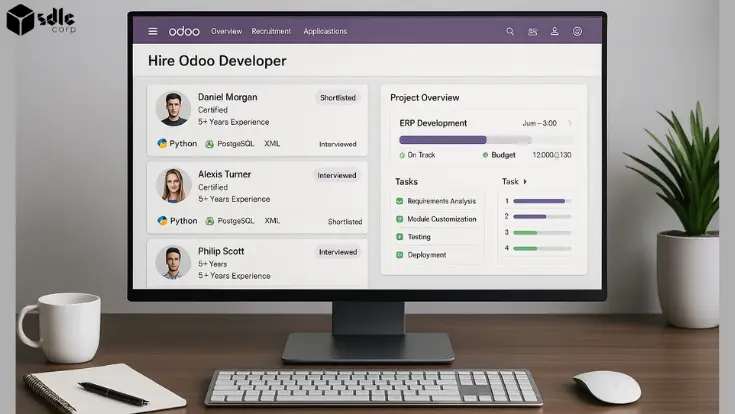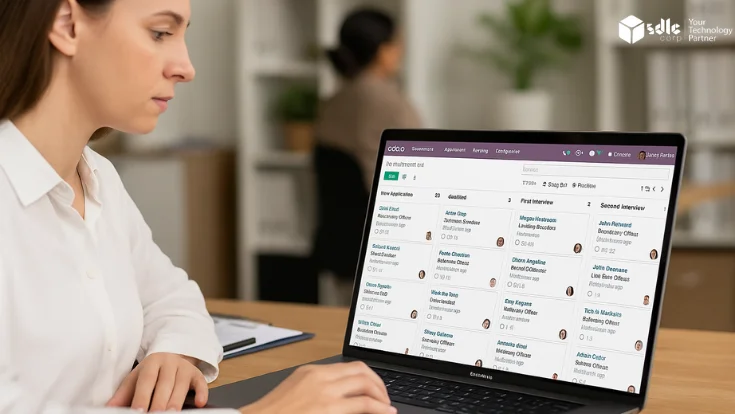Introduction
In the dynamic realm of digital commerce, businesses seek agile, scalable, and customizable solutions to meet evolving customer expectations. Odoo Headless E-Commerce emerges as a transformative approach, decoupling the frontend and backend of e-commerce platforms to offer unparalleled flexibility and performance. This user guide delves into the intricacies of implementing and leveraging Odoo’s headless architecture to build robust, responsive, and feature-rich online stores.
Understanding Odoo Headless E-Commerce
Traditional e-commerce platforms often intertwine the frontend (user interface) and backend (data management), limiting customization and scalability. Odoo Headless E-Commerce disrupts this model by separating these layers, allowing developers to craft bespoke user experiences using modern frontend technologies while harnessing Odoo’s powerful backend capabilities.
Key Components:
- Odoo Headless Architecture: A modular design that decouples the presentation layer from the business logic, facilitating independent development and deployment.
- Odoo Headless API: RESTful APIs enabling seamless communication between the frontend and backend, ensuring real-time data synchronization.
- Odoo Headless Storefront: A customizable frontend interface built using frameworks like React or Next.js, delivering dynamic and responsive user experiences.
- Odoo Headless CMS: A content management system that allows for flexible content creation and distribution across multiple channels.
Setting Up Odoo Headless E-Commerce
Setting up Odoo Headless E-Commerce enables businesses to deliver lightning-fast, customizable storefronts powered by decoupled architecture. By integrating Odoo’s robust backend with modern frontend frameworks like React or Next.js, you achieve full design flexibility and API-driven performance.

Prerequisites:
- Odoo Installation: Ensure Odoo is installed and configured on your server.
- Odoo Add-Ons Path: Identify the directory where custom modules and themes will be placed.
- Frontend Framework: Choose a modern JavaScript framework like React or Next.js for building the frontend.
Step-by-Step Guide:

1. Install the Odoo Headless Module:
- Download the headless module from the Odoo App Store or a trusted Odoo company.
- Extract the module and place it in the Odoo Add-Ons path.Activate the module via the Odoo App interface.
2. Configure the Backend:
- Download the headless module from the Odoo App Store or a trusted Odoo company.
- Extract the module and place it in the Odoo Add-Ons path.Activate the module via the Odoo App interface.
Set up necessary e-commerce functionalities like product catalogs, inventory management, and payment gateways within Odoo.
3. Develop the Frontend:
- Utilize Odoo React Frontend or Odoo Next.js Integration to build a responsive and dynamic user interface.
- Implement Odoo Tailwind CSS for streamlined and customizable styling.
4. Establish API Connections:
- Leverage Odoo REST API Integration to facilitate communication between the frontend and backend.
- Adopt an Odoo API-First Approach to ensure scalability and flexibility.
5. Optimize Performance:
Implement Odoo Static Site Generation and Odoo Incremental Site Regeneration techniques to enhance loading speeds and SEO performance.
Advantages of Odoo Headless E-Commerce
Odoo Headless E-Commerce offers unmatched flexibility by separating the frontend from the backend, allowing seamless integration with modern frameworks like React and Next.js. This architecture enables faster performance, personalized user experiences, and easier scalability across multiple channels.

1. Enhanced Customization:
The decoupled nature of Odoo Headless Development allows for unparalleled customization of the storefront, enabling businesses to tailor user experiences precisely to their brand identity and customer needs.
2. Scalability and Flexibility:
With Odoo Headless Integration, businesses can independently scale frontend and backend components, ensuring optimal performance during traffic surges and facilitating the addition of new features without disrupting existing functionalities.
3. Improved Performance:
Utilizing modern frontend frameworks and techniques like Odoo Static Site Generation leads to faster page loads, reduced server strain, and enhanced user satisfaction.
4. Omnichannel Capabilities:
Odoo Headless CMS empowers businesses to deliver consistent content across various platforms, including web, mobile, and IoT devices, ensuring a unified brand presence.
5. SEO Optimization:
The flexibility offered by headless architecture allows for better control over SEO elements, such as metadata and URL structures, enhancing visibility in search engine results.
Implementing Odoo Headless Themes
Developing an Odoo Headless E-Commerce Theme involves creating a frontend that communicates seamlessly with the Odoo backend via APIs. This approach enables the integration of advanced UI/UX features and ensures a responsive design.

Key Considerations:
- Design Consistency: Maintain a cohesive visual identity across all pages and devices.
- Responsive Layouts: Ensure the theme adapts seamlessly to various screen sizes and orientations.
- Performance Optimization: Implement lazy loading, code splitting, and other techniques to enhance loading speeds.
- Accessibility: Adhere to accessibility standards to provide an inclusive user experience.
Managing Content with Odoo Headless CMS
The Odoo Headless CMS allows for flexible and efficient content management, enabling businesses to deliver consistent messaging across multiple channels.

Features:
- Content Modeling: Define custom content types and structures to suit specific business needs.
- Multi-Channel Delivery: Distribute content seamlessly across web, mobile, and other platforms.
- Version Control: Track changes and maintain content history for auditing and rollback purposes.
- User Permissions: Manage access levels to ensure content integrity and security.
Utilizing Odoo Add-Ons for Enhanced Functionality
Expanding the capabilities of your e-commerce platform is achievable through various Odoo Add-Ons. These modules can be integrated to introduce new features and streamline operations.
Popular Add-Ons:
- Payment Gateways: Integrate with multiple payment providers to offer diverse transaction options.
- Shipping Modules: Automate shipping calculations and tracking.
- Marketing Tools: Implement email marketing, promotions, and loyalty programs.
- Analytics and Reporting: Gain insights into sales performance and customer behavior.
Best Practices for Odoo Headless E-Commerce
- Maintain Clear Documentation: Ensure all integrations and customizations are well-documented for future reference and scalability.
- Implement Robust Security Measures: Protect data integrity and user information through secure API practices and regular audits.
- Conduct Regular Performance Testing: Monitor and optimize loading times, server response, and user interactions.
- Stay Updated with Odoo Releases: Leverage the latest features and improvements by keeping your Odoo instance current.
Conclusion
Embracing Odoo Headless E-Commerce empowers businesses to build flexible, scalable, and high-performing online stores tailored to their unique needs. By decoupling the frontend and backend, organizations can deliver exceptional user experiences, streamline operations, and adapt swiftly to market changes. Leveraging modern technologies like React, Next.js, and Tailwind CSS, along with Odoo’s robust backend, sets the foundation for a future-ready e-commerce platform.
FAQS
What Is Odoo Headless E-Commerce And How Does It Work?
Odoo Headless E-Commerce is a decoupled system where the frontend and backend operate independently. The backend (Odoo) manages data, inventory, orders, and APIs, while the frontend (like React or Next.js) displays content, enhancing performance and flexibility.
Why Should Businesses Choose Odoo Headless Over Traditional Odoo E-Commerce?
Odoo Headless offers faster page loads, better SEO, improved scalability, and the flexibility to use modern frontend technologies like React or Tailwind CSS. It’s ideal for businesses focusing on performance-driven, dynamic online experiences.
How Do I Install The Odoo Headless E-Commerce Module?
You can install the Odoo Headless module by placing it into the Odoo Add-Ons path and activating it from the Odoo App dashboard. This module enables the API-first architecture necessary for headless integration.
Which Frontend Technologies Are Compatible With Odoo Headless Development?
Technologies like React, Next.js, Vue.js, and Angular work seamlessly with Odoo Headless. These can be combined with Tailwind CSS for styling, enabling full customization of the user interface.
What Are The Core Benefits Of Using Odoo Headless Architecture?
The key benefits include faster load times, omnichannel deployment, better user experiences, decoupled design freedom, and easier third-party integration using the Odoo REST API.
Can I Use Odoo CMS And Themes In A Headless Setup?
No, Odoo CMS and traditional themes are not used in a headless setup. Instead, custom themes are developed for the frontend, while the backend provides content and commerce functionality through APIs.
How Does Static Site Generation (SSG) And Incremental Site Regeneration (ISR) Help Odoo Headless Stores?
SSG and ISR reduce server load and enhance SEO by pre-rendering pages at build time or updating them on demand. This is especially effective for Odoo Headless websites built with frameworks like Next.js.


















